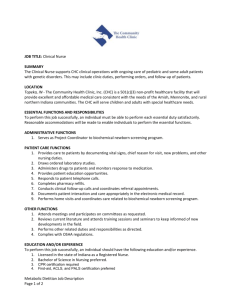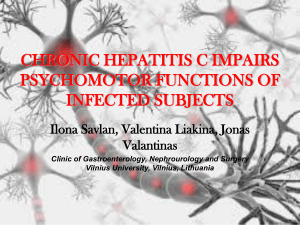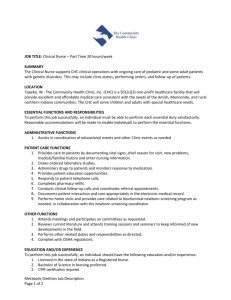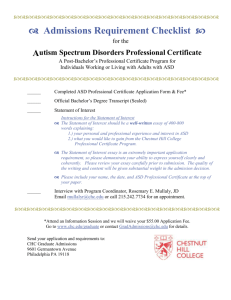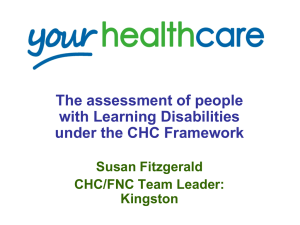Access Alliance Multicultural Health Centre
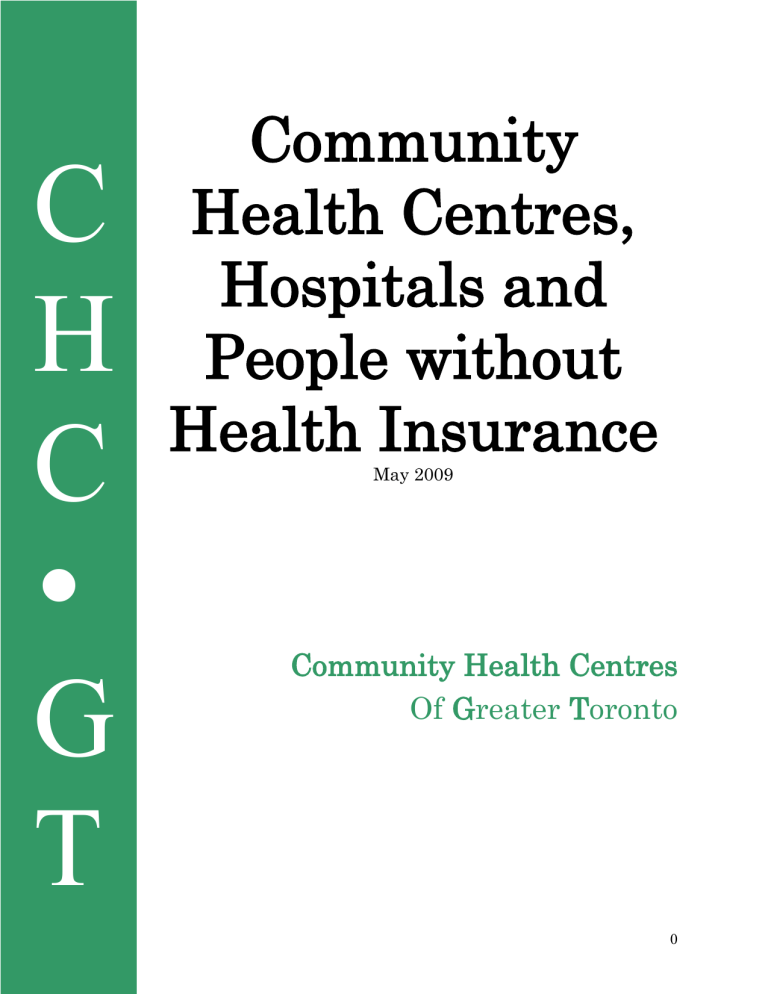
C
H
C
G
T
Community
Health Centres,
Hospitals and
People without
Health Insurance
May 2009
Community Health Centres
Of Greater Toronto
0
Non-Insured Services Task Force of Community Health Centres of
Greater Toronto (current members)
Lori Ann Green-Walker Women’s Health in Women’s Hands
Martha Arbuthnot
Kathryn Miller
Sheila Buckmire
Suzanne Giroux
Kathleen Foley
Sarah Hobbs
Kasia Filaber
Kim Fraser
Access Alliance Community Health Centre
Stonegate Community Health Centre
New Heights Community Health Centres
Centre Francophone de Toronto
South Riverdale Community Health Centre
Planned Parenthood Toronto
Four Villages Community Health Centre
Davenport Perth Neighbourhood Community Health
Centre
Thank you to the people that have been involved in the development of this report:
Safia Ahmed
Thomas Appleyard
Julie Callaghan
Catherine Fergusson
Lucia Furgiuele
Simone Hammond
Sarah Hobbs
Axelle Janczur
Carol Klupsch
Notisha Massaquoi
Sonja Nerad
Soheila Pashang
Lynne Raskin
Parkdale Community Health Centre
Community Health Centres of Greater Toronto
Lawrence Heights Community Health Centre
South Riverdale Community Health Centre
Stonegate Community Health Centre
Parkdale Community Health Centre
Planned Parenthood of Toronto
Access Alliance Multicultural Community Health Centre
West Hill Community Services
Women’s Health in Women’s Hands
Access Alliance Multicultural Community Health Centre
The Four Villages CHC & University of Toronto/OISE
South Riverdale Community Health Centre
Thank you to the members of the Clinical Programs Network for their responses to a survey on these issues.
1
Community Health Centres, Hospitals and People without
Health Insurance
Community Health Centres of Greater Toronto (CHC∙GT) is a collaborative network of 22 Community Health Centres (CHCs) within the Greater Toronto
Area (GTA). The CHCs within the network serve both unique neighbourhoods and/or population groups across the GTA and are recognized for core strengths that include an ability to identify and respond to the specific needs of disadvantaged populations, communities and individuals that face barriers to health. As defined by the CHC Sector
Strategy Initiative, barriers to health include facing access to care barriers, chronic diseases, barriers to the determinants of health and being without health insurance. (CHC∙GT Urban Health Framework, June 2006)
CHCs meet the needs of their communities through the delivery of comprehensive primary health care services, by building individual and community capacity and by delivering and integrating community-based programming.
Community Health Centres recognize that the health of people living in urban settings is the result of the complex interactions among the individual, communities, social and physical environments, and deeply systemic and political forces. Within the GTA and surrounding areas there is a greater likelihood that people will face barriers to health related to their race, sex, colour, ancestry, place of origin, ethnic origin, marital status, sexual orientation, age, gender identity, disability, citizenship, family status or religion AND lack of health insurance.
Urban environments are characterized as diverse with above average concentrations of unemployment, high density-low income areas, new immigrant populations, single parents, isolated seniors and people who are homeless, ill or have a disability. These individuals often live in poor quality and deteriorating housing conditions and experience barriers accessing services, health and health determinants.
This report briefly outlines information regarding people without health insurance in the Greater Toronto Area (GTA) and the role that community health centres (CHCs) play in their health care. It describes problems that
CHCs face when trying to obtain hospital-based care for people without insurance, and outlines recommendations to promote an integrated system.
Since the inception of the Non-insured Services Task Force of Community
Health Centres of Greater Toronto, the task force has been working with hospitals to begin to address the issues outlined in this paper and we are pleased to report that there is a willingness on the part of most hospitals
2
within the GTA to work with CHCs. As this paper outlines, there is much more to be done.
In 2000, Angela, Alberto, and their two daughters came to Canada on a visitor visa to attend a family wedding. While in Toronto, the local news reported an increase of internal conflict in their country. They also heard that Angela’s brother was abducted by the opposition party. Fearful for their lives and with the assistance from their acquaintances in Toronto, the couple met with an immigration consultant who guaranteed them a successful refugee case. The refugee application process cost the couple about six thousand dollars. Angela and Alberto’s refugee claimant case was rejected.
The consultant charged an additional three thousand dollars to file for an appeal, but the Appeal case was also turned down. The immigration consultant never informed the couple about the Humanitarian and
Compassionate (H&C) process or provided them with proper information about other options they might have had, including access to legal aid. The family has no access to the healthcare system. They are currently pursuing the H&C process.
People without Health Insurance in the GTA
There are several reasons why some people living in the GTA do not have health insurance. Some of these people are eligible for health insurance but experience barriers to the procedures. This group includes people who are homeless, people with mental illnesses and children whose parents were not able to afford birth registration when a fee was required for this.
Another group of people without health insurance are people without health insurance. People may be without health insurance for a number of reasons.
An application or appeal may be in process. No application may have been started yet because of fear, misinformation or lack of assistance and resources (Undocumented Workers Project. For Those Who Have None:
Barriers to Status, Toronto, 1998). The discontinuation of a sponsorship or work permit relationships can lead to someone being temporarily without status (Latin American Coalition to End Violence Against Women and
Children. No (Wo)Man’s Land, 2000).
It is estimated that there are over 200 000 people without status living in
Canada and many of them in the city of Toronto (Mojab & Pashang, n.d.).
Although there is no official statistic collected by Citizenship and Immigration
Canada on people without status, some have lived in Canada for twenty years or more.
Many newcomers who find themselves without legal or health care health insurance are essentially permanent residents of Canada and make significant contributions to Canadian society:
3
They work, own businesses, spend their money in Canada, and pay taxes.
They are involved in their communities where they have developed meaningful connections and relationships. They attend schools and raise their families within the community, contributing to the fabric and diversity that defines Canadian culture and values.
Living without legal or health care health insurance has a detrimental impact on people’s lives, on families, on children and on relationships. People without status often do not qualify for public, social, legal and health services and are at higher risk of exploitation. Women without status are at particular risk of physical, emotional, sexual and other forms of abuse.
Some examples include:
Persons who have no status are vulnerable to others who may take advantage of their situation for their own profit, such as immigration consultants, lawyers, employers and other service providers. People without status are often afraid to report crimes or health and safety violations to the authorities.
Living without legal or health care insurance limits a person’s access to health care, education and employment, all of which are prerequisites to healthy living. People without health insurance often wait until they are in medical crisis before seeking care, either because of inability to pay for preventative services or because of fear of authorities. One recent study found that 10.5% of 226 women without status living in the GTA identified fear of being reported as a key barrier to accessing health care (A Collaborative Process to Achieve Access to Primary
Healthcare for Black Women and Women of Colour, 2006)
The stress associated with not having status makes people more susceptible to illness and disease and higher morbidity rates.
People without status may have the concomitant challenge of needing interpretation which requires more time and logistics for systems which are already stretched but without which puts vulnerable persons at even greater risk of being dismissed or not fully understood.
All people living in Ontario should have access to basic health services and programs. However, some CHCs report communities of children that are under-immunized and thus susceptible to infectious diseases. There is good reason for concern about the dangers of emerging infectious diseases when people do not have access to care. At all times, and particularly during a public health emergency, persons who hesitate to access health care for financial or other reasons may pose health concerns for the whole community.
4
Nara lived in an abusive relationship for two years hoping that her husband would change. Every time Nara confronted her husband for his abusive behaviour he silenced her with the threat of breaking down his sponsorship application. It was only when Nara went to women’s shelter that she realized he in fact never submitted her application. Since her separation,
Nara managed to work in various factories to pay for her basic needs. She applied for status under a Humanitarian and Compassionate application.
She decided to work extended hours in order to save for her landing fees.
While working night shift Nara was raped by her employer. He threatened if she tells anyone he will call the police and deport her. Traumatized, Nara kept her ordeal in secret but soon she began to experience flu-like symptoms with high fever. Nara had no access to medical care as she never could afford to pay for doctor fees. Fearing an unwanted pregnancy resulted in Nara visiting a walk-in clinic where she found that she is infected with
HIV. She experienced severe depression, isolated herself from her friends and community, and felt guilty for her rape and illness. Nara shared with her worker that as a divorced women with HIV, death in Canada is a better option than being deported home. She is currently pursuing an application under the Humanitarian and Compassionate process.
The Role Community Health Centres Play in the GTA
Community health centres are funded by the Local Health Integration
Networks to provide some primary care and health promotion services to people without health insurance at no cost. Additionally, CHCs receive some non-recurring funding to pay for the procedures and diagnostics performed by specialists for patients of community health centres. CHCs do not receive funding for associated Clinic fees or Admission fees, which must be paid for by the individual.
Community health centres in the GTA provided health services for approximately 12 000 people without health insurance in the 2005-06 fiscal year. This included approximately 3 500 referrals for specialist care.
OB/GYN referrals represented a significant portion of these referrals – in the range of 60%.
5
Patrick worked in a construction company to support his wife Maria and their three children. Their youngest daughter was born in Canada. She has been labelled by the public school as a special needs child. Although she has
OHIP, since her parents are awaiting a ruling on their status she is not eligible for much public support including social assistance, dental and drug benefits and special devices. Patrick also feels the burden of paying for her two non-Canadian born children’s vaccination and medical cost. Three months ago while lifting heavy equipment at work, Patrick injured his back.
He visited nearest hospital and was diagnosed with a hernia and lower back injury. His doctor asked him to rest, take medication, and prepare for surgery. Maria contacted her social worker at her CHC for help. She needs to find a job and collect money for her husband’s medication and surgery.
Patrick on the other hand feels guilty and depressed for not being able to afford his family’s needs.
Problems that Community Health Centres are Facing
Despite the support from many front-line service providers, the current system is not working well for community health centres or people without health insurance. Problems include:
1) Complicated and Unclear Administrative Processes
Some CHC patients and staff report dealing with administrative processes that seem to change regularly. Often they are dealing with hospital administrative staff that are unfamiliar the Uninsured Patient Agreement.
Most centres have developed forms for patients to take with them to appointments or to the emergency room advising that the patient is uninsured and centre can be billed for procedural and diagnostic fees.
However, patients are still asked repeatedly for an OHIP card and physicians often do not provide services out of concern that they will not receive payment. Community health centres see patients who are turned away from hospitals because of their uninsured status, and/or because they require interpretation which cannot be arranged.
Some hospitals charge a facility fee that is geared to income. This process is complicated for patients without health insurance and risks leading to errors and appeals.
2) Non-standardized fees
6
CHCs do not pay facility fees, but several are involved in negotiating with hospitals on these fees, or advising patients on how they can negotiate.
Requests ahead of time for what certain procedures will cost have gone unanswered. Fees charged by hospitals vary from hospital to hospital.
Negotiations vary from centre to centre, and patient to patient. Costs for diagnostic and procedural fees often do not reconcile with OHIP rates or
OMA rates.
It is unreasonable that fees must be negotiated on a patient-by-patient basis when a Local Health Integration Network is paying for the bill. A standardized, system-wide fee scale for non-insured persons would be simpler and fairer.
3) Rising fees
Rates for clinic fees, admission fees and procedure fees are high and rising significantly. For example, one hospital’s admission fees have gone from
$600 to $1 000 per day in the past few years. Many CHC patients report that they are carrying significant debts to the hospitals. Community health centres experience limited ability to refer to certain hospitals when there are high facility fees. Other hospitals and some specialists also charge up-front for services, placing further burden on the patient and the system.
Some other specialists outside of hospital practices charge only OHIP rates with no facility fees. This works well when such agreements can be negotiated.
Many physicians who work in Family Practice or Community Clinics in local hospitals concur with these identified problems. They have participated with community health centres in helping mutual patients on a case-by-case basis with senior hospital administrators. In some instances, they have also advocated on the need for a system-wide response within their own hospitals.
Recommendations
There are a number of recommendations which would strengthen a more integrated link between hospitals and community health centres for people without insurance.
1) Clinic and/or facility fees for non-insured patients should be waived.
2) If clinic or facility fees cannot be waived, any fees that are paid by non-insured patients should be reasonable, standardized among hospitals and determinable in advance.
7
3) Procedural and diagnostic fees should be based on OHIP rates.
4) Easy and standardized administrative procedures should be identified and made available to patients in a format that can be easily translated and understood by the patient, CHCs and Hospital staff.
5) Each hospital should have a contact person(s) for CHCs who is familiar with this issue and the role that CHCs play.
6) CHCs and hospitals should streamline their financial assessment tools so that the financial assessment that the CHC completes would be adequate for the hospital’s use, thereby easing the process for the clients as well as the service providers.
7) Utilize pre-determined and agreed upon templates for letter of referral
(Appendix A) and contracts (Appendix B) intended to implement these recommendations.
8) If a patient that has started care/treatment with a hospital moves out of the hospital’s catchment area, but continues to remain a CHC patient, allow the client to finish the treatment/care following the above guidelines.
8
Appendix A:
Uninsured Letter for CHC use
CHC Logo
Financial Department
Attention: [Contact]
RE: [Client Name]
[Client Address]
Dear [contact]
Thank you for seeing our client. Based on our CHC financial assessment, we have determined that this client is not insured and has limited financial resources. This client is eligible for the terms outlined in the Uninsured Patient Agreement with Community
Health Centres.
As part of this agreement, our CHC will pay for the diagnostic tests and physician fees covered by OHIP at OHIP rate for this visit only. Should the client require further medical services please contact [CHC contact] for approval.
Please invoice the CHC for these services and include the following information:
Client Name
Client Date of Birth
Date of Service
Description of Service
OHIP Billing Code
OHIP amount
If you have any questions about the CHC agreement with [hospital name] please contact [CHC director/manager of health services].
Thank you for assisting with this client ’s care.
Sincerely
[CHC staff making referral]
9
Appendix B: Contract Template CHC/Hospital Agreement
NAME OF HOSPITAL & LOGO
Uninsured Patient Agreement with Community Health Centres
Community Health Centres (CHCs) are non-profit, community governed, interdisciplinary health centres that provide primary care. Many patients of CHCs do not have access to health insurance. CHCs receive limited funding to pay for the procedures and diagnostics performed by specialists. CHCs do not receive funding for associated facility fees. CHCs serve clients that are marginalized, face barriers to care and are impoverished. The goal of this agreement is to outline the obligations of each party and to determine the terms of the agreement.
This agreement outlines the criteria that will be considered before insert name of hospital
(hereafter “ insert acronym ”) will accept patients referred by the Community Health Centre
(hereafter “CHC”).
Criteria for Acceptance of patient by (insert name of hospital)
To be accepted as a patient by (insert hospital acronym) , the patient must meet the following criteria: a) b) c) d)
Prior to providing care, (insert hospital acronym) must have received a referral letter from the CHC to confirm that the patient is a client. The letter will outline the services required. (Insert hospital acronym) may contact the CHC to confirm the details of the letter; and,
If the patient arrives without a referral letter, as in an emergency situation, verbal authorization from the CHC must be received by (insert hospital acronym) prior to providing care. A referral letter will follow; and,
Requires care or treatment from the physician(s) at (insert hospital acronym) ; and,
(If applicable) Lives in or is eligible for the (insert hospital acronym) ’s catchment area which is defined as (insert hospital catchment) :
Note: A referral letter template has been attached for CHCs to use or adapt for the purpose of referring clients to ( insert hospital acronym).
Rates and Fee Coverage a) Diagnostic tests. These will be charged to the CHC at the current established OHIP rates. b) Physician/Specialist fees. These will be charged to the CHC at the current established
OHIP rates. c) ( insert hospital acronym) will waive the facility fee for CHC clients in all of its clinics, programs and for all inpatient stays.
10
Physician Fees
Physicians at (insert hospital acronym) will bill the CHC at the current established OHIP rates for non-insured patients that are referred by the CHC.
Physician fees for follow up or ongoing care must be approved by the CHC prior to service or treatment.
Key Contact Information:
(Insert hospital acronym) will make every effort to educate its staff about the agreement with
CHCs.
(Insert hospital acronym) and CHCs will identify a key contact person that will be responsible for dispute resolution or if further information is required. The contact information is available on the attached contact list. Each party is responsible for communicating new or changing contact information in a timely manner.
Termination
Should any party wish to terminate this agreement, three (3) months written notice will be provided.
Agreement Term
This agreement will continue until (date – typically 5 years) . The end date of this contract may be extended at any time during the duration of this contract with the written consent of all parties. Review of the agreement implementation may occur at the request of either party.
Contact information
The mailing address and contact information of all parties is outlined as follows. This contact person will be the first point of contact for any dispute resolution or if further information is required:
Name of hospital
Name:
CHC 1: name
Name:
Title:
Address:
Title:
Address:
CHC 2
Name:
Title:
Address:
CHC3
Name:
Title:
Address:
11
CHC 4
Name:
Title:
Address:
CHC6
Name:
Title:
Address:
AGREEMENT SIGNATURES:
CHC 5
Name:
Title:
Address:
CHC 7
Name:
Title:
Address:
This agreement shall be governed by and interpreted in accordance with the laws of the
Province of Ontario.
Name of hospital
Address
Per:
Name:
Title:
I/We have authority to bind the
Corporation.
CHC 2
Per:
Name:
Title:
I/We have authority to bind the
Corporation.
CHC 4
CHC 1: name
Address
Per:
Name:
Title:
I/We have authority to bind the
Corporation.
CHC3
Per:
Name:
Title:
I/We have authority to bind the
Corporation.
CHC 5
12
Per:
Name:
Title:
I/We have authority to bind the
Corporation.
CHC6
Per:
Name:
Title:
I/We have authority to bind the
Corporation.
Per:
Name:
Title:
I/We have authority to bind the
Corporation.
CHC 7
Per:
Name:
Title:
I/We have authority to bind the
Corporation.
13
Access Alliance Multicultural Health Centre www.accessalliance.ca
Anne Johnston Health Station www.ajhs.ca
Black Creek Community Health Centre www.bcchc.com
Central Toronto Community Health Centres www.ctchc.com
Centre Francophone de Toronto www.centrefranco.org
Davenport-Perth Neighbourhood Centre www.dpnc.ca
East End Community Health Centre
(416) 778-5858
Flemingdon Health Centre www.fhc-chc.com
The Four Villages Community Health Centre www.4villageschc.ca
LAMP Community Health Centre www.lampchc.org
New Heights Community Health Centres www.newheightshealth.org
Oshawa Community Health Centre www.ochc.ca
Parkdale Community Health Centre www.parkdalehealth.ca
Planned Parenthood Toronto www.ppt.on.ca
Regent Park Community Health Centre www.regentparkchc.org
Rexdale Community Health Centre
(416) 744-0066
South Riverdale Community Health Centre www.srchc.com
(416) 461-1925
Stonegate Community Health Centre www.stonegatechc.org
West Hill Community Services www.westhill-cs.on.ca
Women’s Health in Women’s Hands www.whiwh.com
York Community Services www.ycservices.com
The Youth Centre www.theyouthcentre.ca
14
